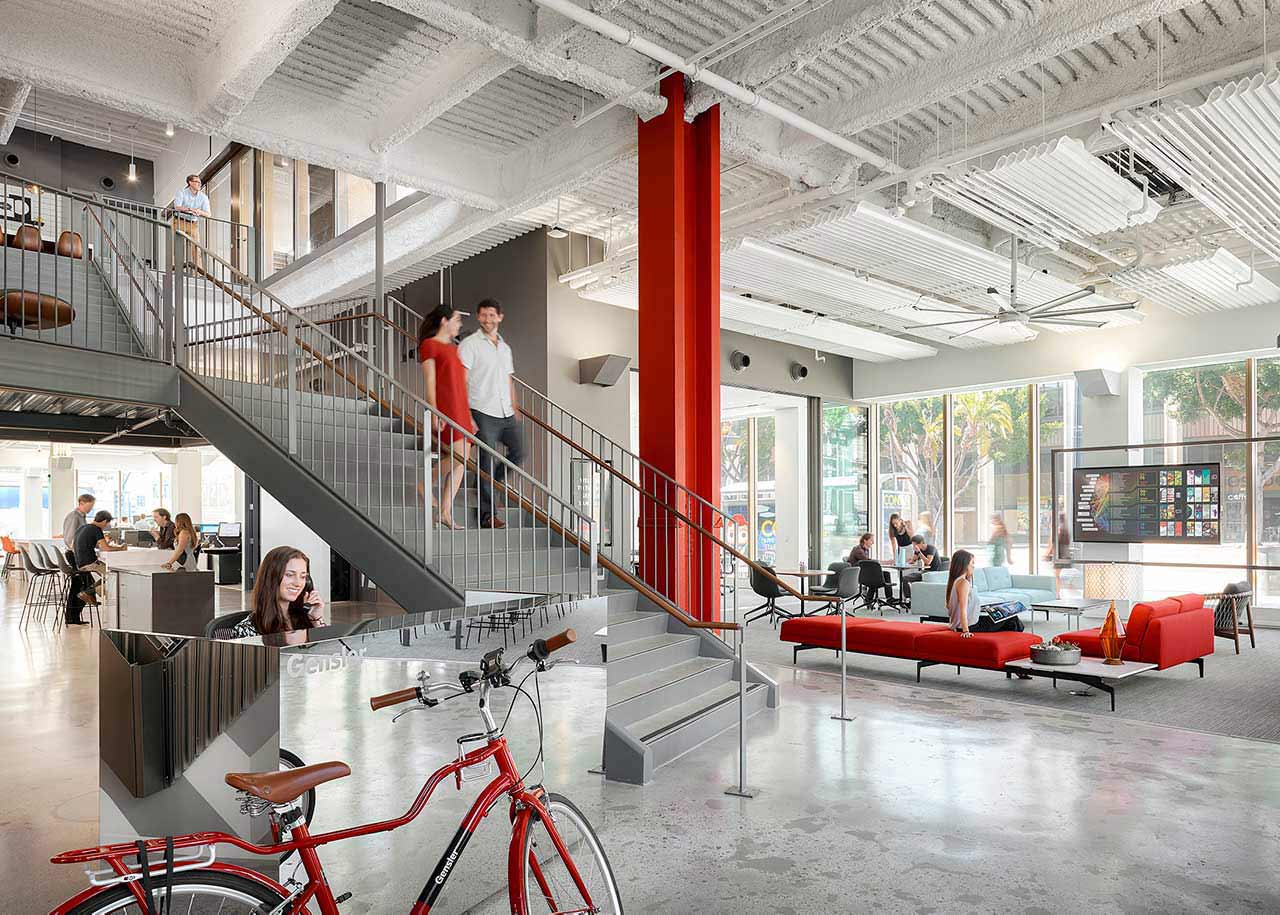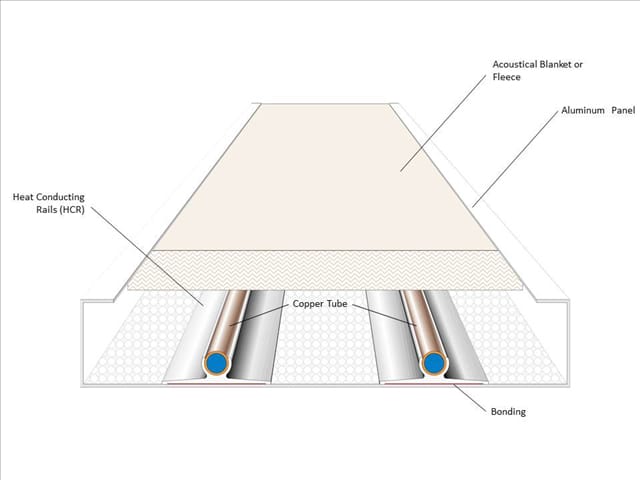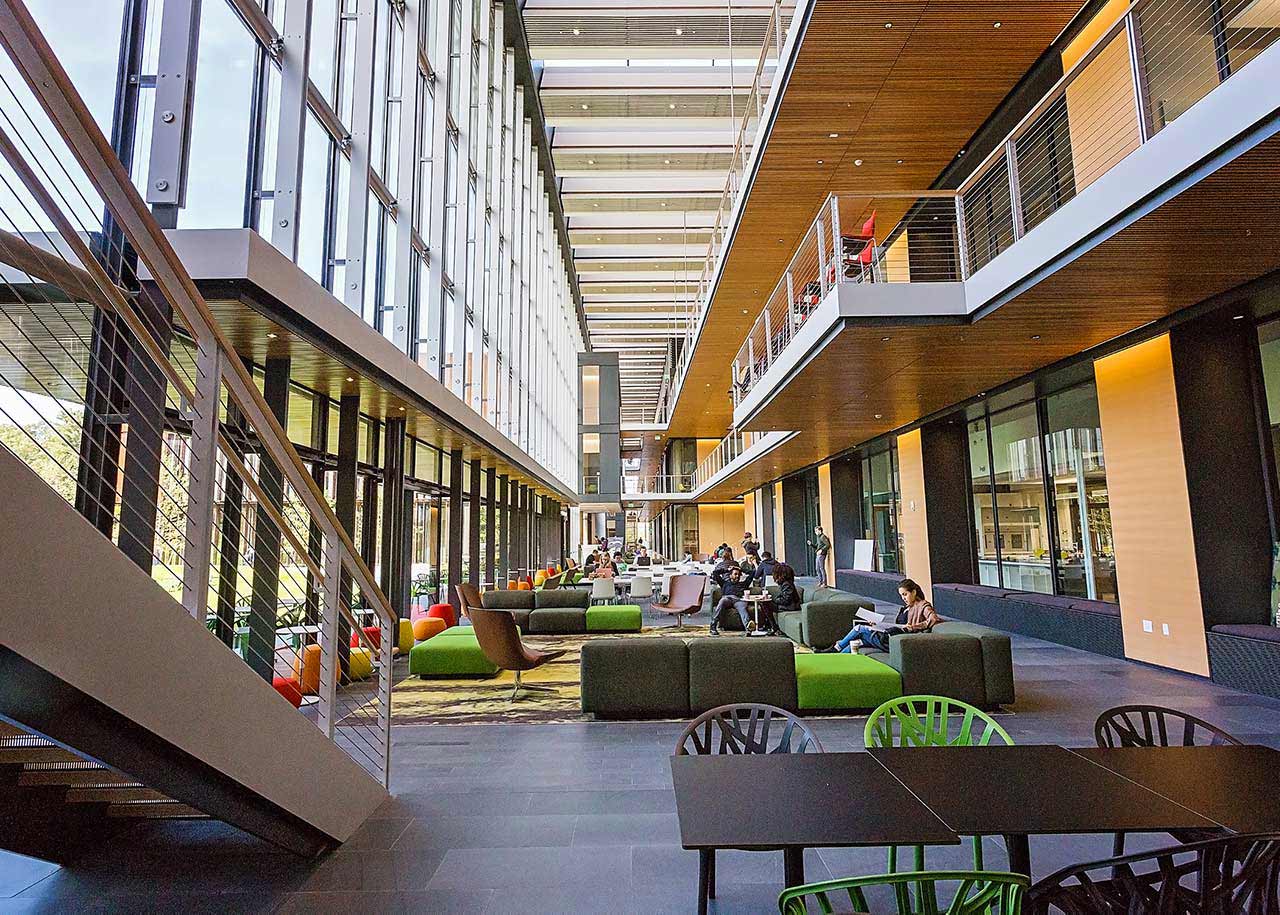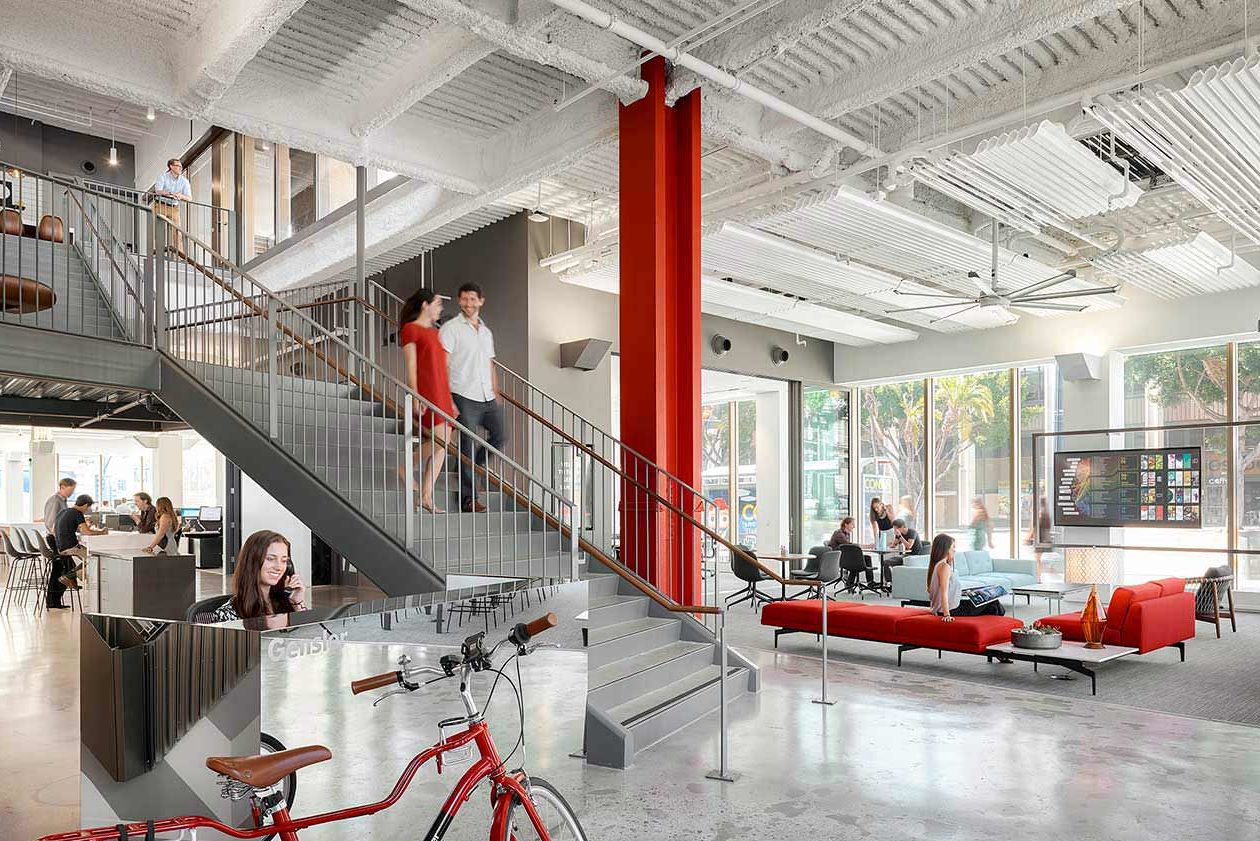
Gensler’s office in San Diego, California is a great example of waves applied in an open space for both the aesthetic and functional advantages they provides. Photo by Ryan Gobuty
Barcol-Air’s radiant heating and cooling systems and active beams improve health while controlling climates—and costs.
Forced air systems have been a common heating and air conditioning method in commercial buildings and old industrial sites for decades—until now. As architects and designers seek energy-efficient, design-friendly radiant systems, they increasingly recognize the benefits that radiant heating and cooling systems offer. Barcol-Air’s first-class heating and cooling systems are defining the architecture of a space like never before.
Radiant solutions have long been popular in Europe, even as they continue to gain steam in the US. Barcol-Air itself has been a large part of the excitement. The company has celebrated a long, well-earned reputation in Europe, having been founded in Switzerland in 1979 as a leading manufacturer of radiant heating and cooling systems and active beams. After years of extensive research, the company refined its concept of radiant heating and cooling technology, making it available for commercial applications.
The company’s products are known for their style and performance, according to Michael O’Rourke, national sales manager at Barcol-Air. “No matter how ambitious the concept, our team will work to create custom designed systems that perfectly complement the owner’s or designer’s vision,” he says.
In fact, today’s high-end architecture teams and designers committed to net-zero projects turn to Barcol-Air’s radiant solutions for a myriad of reasons—especially aesthetics and energy savings.

A radiant panel is made up of a flat copper coil that’s mechanically pressed or welded onto strips of aluminum that are thermally bonded to the back of a regular metal Lay-In or Torsion Spring ceiling panel. Illustration courtesy of Barcol-Air
Barcol-Air in Action, from Nike to Gensler
Barcol-Air’s climate control technique has improved buildings all over the US, from the Nike World Headquarters and Gensler’s San Diego building to US Army Corps of Engineers.
At Gensler, Barcol-Air helped the Gensler and Glumac project team bring their vision to life, including implementing passive natural ventilation as well as radiant waves and chilled beams, improving the health and comfort of the building’s occupants.
At Nike, the architectural design team incorporated Barcol-Air’s radiant ceiling panels among other sustainable elements. Both projects incorporated the Barcol Radiant Wave (BRW) for its innovative and visually appealing design. It’s virtually maintenance-free, provides thermal comfort by radiation, and acts as a heat exchanger. “We’re constantly advancing our technology and methods and have recently adopted Active Beam technology to help our clients create beautiful spaces with all-encompassing heating and cooling operations,” O’Rourke Says. “These fully integrated heating and cooling operations further enhance a building’s LEED accreditation.”

A combination of waves and ceiling panels are used in Nike’s world headquarters in Oregon to meet mechanical requirements and the architect’s vision. Photo by Garrett Rowland
What is Radiant Cooling?
Radiant cooling is a transfer of energy, mainly through radiation, based on temperature differences between space surfaces and occupants. Essentially, radiation can travel through a vacuum at the speed of light, so it’s not dependent on air movement to transfer heat loads.
Solid objects of different temperatures transfer energy without operating on the air in between, so technically, the distance between the objects has no bearing on the radiant portion of the energy transfer. Each Barcol-Air system runs on hydronic energy and is designed with energy savings and sustainability in mind.
The result? More efficient heating and cooling at a fraction of the cost of forced air systems.
Unique System Applications
Barcol-Air manufactures premium radiant heating and cooling systems that deliver optimal comfort using advanced thermal exchange methods. Entire system solutions are at the core of the company’s product offerings.
“Radiant can be used for sensible loads—both heating and cooling—and to offset any radiant asymmetry due to cold or hot walls or glass facades in the space,” O’Rourke says. “But it’s not appropriate for fresh air or dehumidification requirements.”
Therefore, the company offers advanced Active Chilled Beam technology to provide each space with an additional level of ventilation and dehumidification, creating fully integrated heating and cooling operations that positively contribute to the building’s LEED accreditation.
Barcol-Air’s Active Beam application offers significant space savings, too, thanks to smaller ductwork requirements. It can be installed tight up against the slab, resulting in reduced floor-to-floor heights and reduced construction costs on new buildings. In addition to low maintenance requirements, Active Beam systems also use the same water temperatures used in radiant panels and exude low noise levels.
What is a Radiant Ceiling?
Radiant ceiling systems are ideal for both new and renovated buildings. Radiant ceilings are available in custom configurations and should be considered any time there is an asymmetric radiant load, like an exterior wall, and especially in high glass areas. They are also ideal where energy savings are important, as they can reduce the amount of recirculating air—saving fan power energy and reducing HVAC system energy use by 30 to 40%.
“Radiant should also be considered on projects with high envelope integrity and/or low E glass,” O’Rourke says. “One of the limitations is that most radiant systems don’t have a high per square foot output, therefore leaky buildings or high energy loss buildings may require excessive areas of the ceiling covered by radiant and/or higher amounts of air from the air system.”

Photo by Tamara Bowman
Aesthetics & Design Capability
Although radiant doesn’t eliminate the need for an air system, it does significantly reduce the amount of air being moved in the building—so ductwork is decreased by as much as 60 to 70%. “Water is a much better energy transfer medium than air,” O’Rourke says. “While you still have to supply outside fresh air for ventilation and dehumidification, the ductwork is significantly smaller since only the outside fresh air is required and not all the recirculated air of a standard air system.”
In addition to the reduced ductwork, the ceiling panels offered within the Barcol-Air system can be selected based on the architectural design of a space, allowing for easy accommodation of lighting equipment, fire protection systems, support grid systems, and hidden support systems.
Long-term Performance
When compared to a variable air volume (VAV) system, Barcol-Air’s radiant systems offer maximum energy savings while also providing architectural freedom and minimal space requirements. Obviously cost savings vary depending on the location of the project energy costs and the construction and design of the project itself, but most projects see energy savings of 30 to 40%. Here’s why: The specific heat capacity of water is four times higher than air. To remove a given amount of heat from a building, less than 25% of the transport energy is required to remove the same amount of heat compared to an all-air system.
Barcol’s radiant ceiling systems operate at higher cooling water temperatures than all-air systems, allowing for heat pumps and chillers with very high coefficients of performance. “Because a radiant system has very few moving parts, maintenance is very minimal, resulting in saved operating costs,” O’Rourke says. “As energy costs become greater, the savings accrued will also increase.”

Photo by Garrett Rowland
Health Benefits
The so-called “sick building system” is simply nonexistent in buildings with radiant systems thanks to the elimination of recirculated air. People with allergies often prefer radiant heat because it doesn’t distribute allergens like forced-air systems can. In fact, Barcol-Air’s system offers a wealth of control considerations so air quality can be maintained.
The Active Beam system maintains constant control of humidity and guarantees minimum fresh air delivery. In addition, the control system allows for room dew point monitoring with the help of small, high-quality sensors that can be located in the room rather than in the ceiling.
By separating the sensible airside loads and treating them directly—especially in areas with radiant asymmetry—there are much higher levels of comfort for building occupants. “By reducing the amount of air movement in the space, we also make the space much quieter,” O’Rourke says. “Indoor air quality is enhanced as well, since we are only bringing in fresh air and exhausting internal building/room air, providing exceptional ventilation effectiveness.”
About Barcol-Air
In 2007 the fully independent Barcol-Air USA was established by the company’s original founder, offering the US market the exceptional radiant systems and active beam products Europe has embraced for decades.
Barcol-Air systems are “low mass” systems, using copper tubes and aluminum as opposed to embedded tubes in floors or ceilings. These low mass systems respond quickly to interior or exterior load changes. Even more importantly, these systems can react quickly to changes in radiant loads on exterior walls and fenestration. This low mass feature also allows it to respond quickly in the case of buildings using operable windows, as are many times used with LEED design projects. Water supply to the cooling panels can be shut down when windows open and reach room temperature within three to five minutes, avoiding any potential for condensation.
During its 40-year history Barcol-Air has consistently advanced its technology to become the leading provider of radiant heating and cooling systems and active beams. By blending modern, custom design with superior performance, the company helps create systems that not only look great, but provide an environment building occupants find comfortable and can offer exceptional energy savings. In fact, Barcol-Air radiant systems provide an average 30% in energy savings over conventional air systems, offer 27% less average electrical peak power demand, and require 35% less plenum space.



